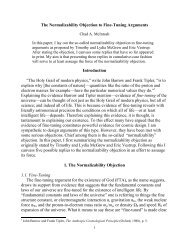Theism and Explanation - Appeared-to-Blogly
Theism and Explanation - Appeared-to-Blogly
Theism and Explanation - Appeared-to-Blogly
You also want an ePaper? Increase the reach of your titles
YUMPU automatically turns print PDFs into web optimized ePapers that Google loves.
What Would They Explain? 69<br />
must offer an answer. It must tell us why God would choose any created<br />
cause, let alone this one, as the means of achieving his goals.<br />
Let me set these issues aside for the moment. If theistic explanations are<br />
intentional explanations, the charge of explana<strong>to</strong>ry redundancy is perhaps<br />
not as serious as it might appear. For in the case of intentional explanations,<br />
there does seem <strong>to</strong> be a sense in which one can offer two explanations<br />
of the same fact. An intentional explanation tells us of what the agent was<br />
trying <strong>to</strong> achieve in performing this action. A natural-scientifi c explanation<br />
describes the mechanism that brought about the action. Neither explanation<br />
would be complete, 35 in the sense that each approach “leaves some<br />
explanation-seeking questions unanswered.” 36 But as I have argued above<br />
(1.3.3), an incomplete explanation is still an explanation. 37 This is, in fact,<br />
the solution adopted by Richard Swinburne. As Swinburne writes, “the<br />
motion of my h<strong>and</strong> may be . . . explained by goings-on in the nerves <strong>and</strong><br />
muscles of my arm, <strong>and</strong> physiological laws. It may also be . . . explained by<br />
me bringing it about, having the intention <strong>and</strong> power <strong>to</strong> do so.” 38 Assuming<br />
that the motion in question was an intentional act, this seems correct. Each<br />
explanation is telling us something different about the event.<br />
Explaining under a description. But <strong>to</strong> show that intentional <strong>and</strong> non-intentional<br />
explanations can be complementary is not yet <strong>to</strong> escape the charge of<br />
explana<strong>to</strong>ry redundancy. The events I am discussing here are those that have<br />
an accepted natural explanation. The question the atheist can pose <strong>to</strong> the<br />
theist is this: If you accept the natural (perhaps non-intentional) explanation,<br />
why do you want <strong>to</strong> offer an intentional explanation as well? What we need <strong>to</strong><br />
remember here is that any fact is explained only under a particular description<br />
(3.2.2). What the physiological explanation explains is why my h<strong>and</strong> moved;<br />
it does not purport <strong>to</strong> explain why I moved my h<strong>and</strong>. 39 So <strong>to</strong> say that a fact<br />
already has a successful natural explanation is <strong>to</strong> say that there exists some<br />
description of that fact under which it can be explained in non-intentional<br />
terms. So if the theist wishes <strong>to</strong> argue that the same event requires a complementary,<br />
intentional explanation, she must show that there exists another true<br />
description of the event that requires this new kind of explanation.<br />
If this is correct, it does have a surprising implication. When setting out<br />
<strong>to</strong> prove the existence of God, theists generally begin with facts whose natural<br />
explanation they reject. They may be naturally inexplicable (4.3.2.2)<br />
or merely naturally unexplained facts (4.3.2.1), or they may be facts whose<br />
natural explanation the theist contests (4.3.3.2). But on my account, they<br />
are under no obligation <strong>to</strong> do so. A theist could, in principle, begin with a<br />
fact that has a natural explanation, one he does not contest. He could admit<br />
that there exists a true description of this fact—analogous <strong>to</strong> “why my h<strong>and</strong><br />
moved”—under which it can be explained without (immediate) reference <strong>to</strong><br />
God. But he could seek <strong>to</strong> show that there exists another true description of<br />
this fact—analogous <strong>to</strong> “why I moved my h<strong>and</strong>”—that dem<strong>and</strong>s an intentional,<br />
theistic explanation.



